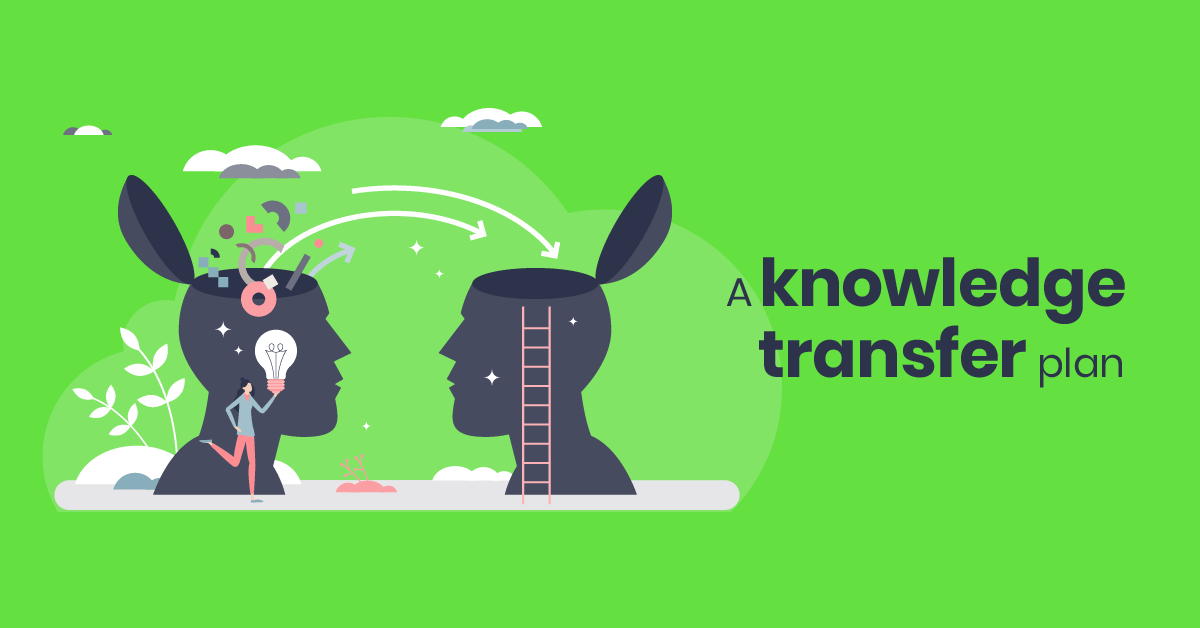She’s built up good relationships with some demanding and tricky clients and regularly exceeds her personal growth targets. You’re not 100% sure how she performs so well, so consistently, but you don’t need to, right?
Wrong. The bad news is, Kate’s just handed in her notice. In two weeks she’ll leave, taking all of her knowledge and experience with her. Or will she?
The good news is there’s a solution: using a knowledge transfer plan. “A what?” OK. If you haven’t got or heard of a knowledge transfer plan you’re not alone. But could now be the time to start thinking about it? (Before your own Kate hands in her notice.)
If you’re trying to decide whether or not your team needs a knowledge transfer plan, here’s some info to help.
What is a knowledge transfer plan?
A knowledge transfer plan captures critical information from experts across your business and ensures that it’s structured, stored, and transferred to everyone who could benefit from it.
Impacting both organizational culture and systems, its main objective is to minimize the risks associated with the loss of talent and knowledge in an organization. And its main challenges are how to capture the knowledge, how to transfer or share it, and how to keep it up-to-date.
So, that’s what it is. Let’s look at what it’s not.
It’s a thin line between knowledge transfer and…
… learning and development
Just to be clear (because the distinction’s kind of blurry), a knowledge transfer plan isn’t the same as L&D. What we’re talking about here is the transfer of wisdom, experience, and insights through on-the-job training rather than through prescribed lessons delivered in a formal learning environment.
This on-the-job transfer of knowledge can take various forms, from peer mentoring and work shadowing to informational interviews and apprenticeships. And, while it’s not L&D, this practice of leveraging the knowledge invested in people does reduce the pressure on formal employee training programs in many organizations.
… knowledge management
An umbrella term for the discipline or practice of identifying, producing, and sharing knowledge across a company. Knowledge management encompasses the interaction between people, processes, and tech and is usually linked up with organizational objectives.
Knowledge transfer focuses on “how” knowledge management can be achieved through on-the-job training. It covers the purposeful exchange of knowledge between an expert who provides knowledge to an individual, team, unit, organization, or group of organizations, who receives it, processes it, and synthesizes it. It is closely linked with the success of a company’s knowledge management activity.
… knowledge sharing
Driven less by defined purpose or experts, knowledge sharing is the informal, socialized exchange of skills, expertise, and knowledge among people, employees, and different parts of the organization.
In the know
The one obvious thing that links all of these concepts together is knowledge. And to really get under the skin of knowledge transfer, it’s helpful to examine the differences between data, information, and knowledge.
- Data is about raw, hard facts. It’s the means of creating information. But on its own, it carries no judgment, interpretation, or meaning.
- Information is organized data that’s been analyzed and presented to an audience. Information has the potential to change how someone perceives something.
- Knowledge is rich, meaningful, and more complex. It’s difficult to organize because it’s acquired through experience, reasoning, intuition, and learning. Knowledge can be divided into three types:
- Explicit knowledge that’s easy to share and document
- Implicit knowledge that’s the application of explicit knowledge (i.e. transferable skills)
- Tacit knowledge that’s acquired through experiences, observations, and insights
Because the nature of knowledge is complex, some organizations invest in a formal knowledge management platform or learning management system to support their knowledge transfer plan.
These centralized systems record, store, and manage institutional knowledge and best practices. They can be useful, particularly for promoting consistency, collaboration, and ease of access.
When to create a knowledge transfer plan
The oldest generation now in the workplace, baby boomers, is quickly moving to retirement. And younger employees won’t stay at the same job for more than three years.
If either of those scenarios rings true and you’re wondering whether your team needs a knowledge transfer plan, it might be time to take action. But they’re only two examples. Below are some of the most common reasons for adopting one (we’d place a bet that at least one of these is familiar to you):
- A key member of your team is leaving and who knows who might be next?
- You’re launching an internship program and need to boost your onboarding packet
- Lots of your team members are nearing retirement
- You’ve been asked to advertise a popular post for internal promotion
- You need to downsize and make sure critical information is retained
- It’s time to scale and standardize your knowledge transfer strategy
- Most of your workforce is now remote and requires cross-team collaboration
The goals of a knowledge transfer plan
We’ve talked a lot about how having a knowledge transfer plan can minimize the risk that a loss of talent and knowledge places on a business. This is undoubtedly a very big win. But, there are other benefits to consider:
A commitment to development
Having a knowledge transfer plan in place recognizes the values that individuals bring to an organization. It also shows a commitment to the growth and development of others in the team. And this, in turn, raises levels of engagement and retention.
Support for scalable learning
A knowledge management strategy, scalable learning is decentralized learning that’s driven by employees. Encouraging a culture of constant, in-the-workflow L&D, these internal subject matter experts (SMEs) generate familiar and relevant content that’s used to develop and empower colleagues.
Sounds familiar? Yes, the goal of a knowledge transfer plan fits seamlessly within this strategy.
Opening up organizational silos
Promoting a knowledge-sharing culture across an organization is a good way of breaking down the barriers that often exist between different departments and within teams. Communities of practice are a good example of this.
Often created or encouraged to grow as part of a knowledge transfer plan, these collaborative groups are made up of people united by a particular interest or passion. Operating primarily through digital channels such as Slack or Facebook, these groups transcend the siloes associated with geography, time, and language as well as business division or department.

How to build a successful knowledge transfer plan
So, you think you could benefit from having a knowledge transfer plan. Good decision. But what’s next?
Here’s a step-by-step guide:
Step 1: Identify
- Examine risk(s) — is there one issue, in particular, that’s putting your business at risk? If so, what is it? If there’s more than one, list them all.
- Highlight department(s) — what business areas are most impacted by the risk? What are the functions of this team?
- Focus on people — who are the key people or SMEs in that division? What activities do they perform?
- Target knowledge — what’s the most important information you need to extract from those SMEs to be able to perform those activities? (Remember your SMEs are going to be busy with other stuff so give them a clear and realistic framework that highlights priorities to follow.)
Step 2: Prioritize
- Grade importance — what information is most needed to keep business operating effectively?
- Determine availability — how many people possess this knowledge?
- Assess frequency — how often is this knowledge required?
Tip: Try using a formula to assess priorities. For example, apply a 1 to 3 ranking to each category, add up the total, and then assign either a high, medium or low category to determine priorities.
Step 3: Capture
- Define the type of information you’re trying to capture — tacit, transient, implicit, explicit.
- Match the type of information with an appropriate format — for example, mentorship, paired work, guided experience, work shadowing, informational interviews, and coaching are good for capturing tacit knowledge. Guided experience, documentation, simulation, wikis, and job aids are best suited for explicit knowledge.
- Clarify and describe roles so there’s no ambiguity — for example, what’s required of a “mentor” or an “apprentice.”
Step 4: Transfer
- Use the right tech (audio, video, transcripts, images, graphics, charts) to present and transfer knowledge to your teams. It’s at this stage when you’ll appreciate having a learning management system in place. Especially, a platform that keeps learners engaged with its interactive features.
- Check security and privacy levels — establishing the type, context, and confidentiality levels of the information will determine how widespread the transfer of knowledge can be.
Step 5: Store and sustain
- Organize knowledge so it’s easy to find. A tech-based knowledge management system can help provide a searchable, easy access route to information.
- Keep knowledge up-to-date by assigning responsibility to an individual or team or by providing a social framework (i.e. a Wiki) for collective responsibility.
Don’t forget the water cooler
Having a structured and purposeful process in place is the bedrock of a successful knowledge transfer plan. But it’s important to keep alive the unofficial sharing of knowledge that takes place on a daily basis in every organization.
Whether it’s a chat over lunch or by the water cooler, regular stand-ups or informal debriefs, a chance encounter in the lift or a train of thought shared through social media, remember to encourage and promote these, too.
Combined with a well-thought-through knowledge transfer plan, these interactions will help you capture and grow a rich repository of information to make your business resilient, robust, and ready for anything (even the loss of Kate).
A compelling case
Ensuring that productivity, competitiveness, and delivery continue unaffected by staffing changes, a knowledge transfer plan is more than just a way to reduce risk. It also has the potential to increase profits and output.
By giving more people access to specialist knowledge and skills, and by building up transparency of critical information, people and processes work more efficiently. Many companies even find that the time from hire to productivity is shorter and that the costs associated with delivering employee training programs are also reduced.
And that’s why you need a knowledge transfer plan.



